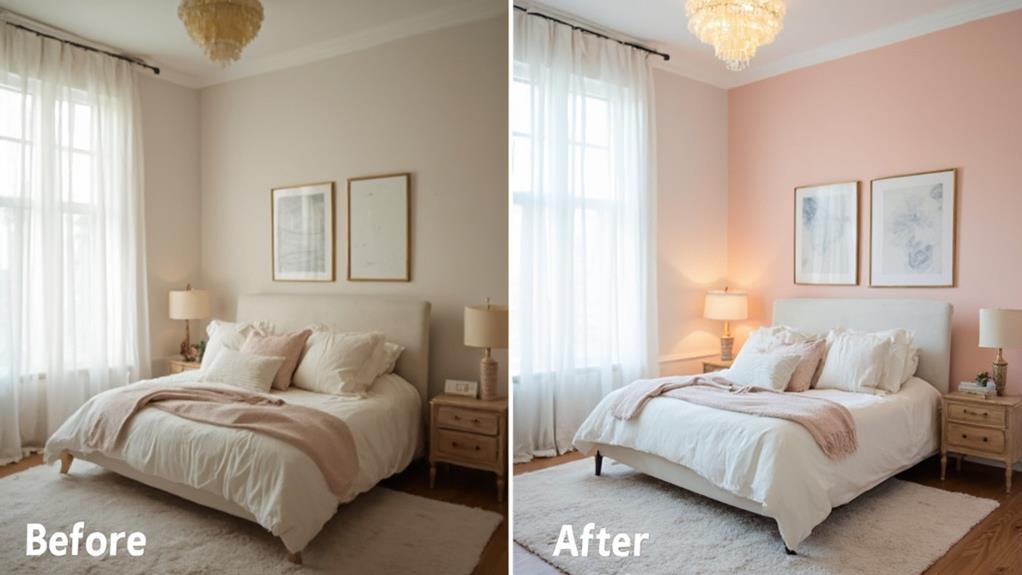Revamping your space with a chic paint redo starts with understanding color psychology. Remember that cooler hues like blues and greens foster relaxation, while warmer ones like reds and oranges, energize your space. It's not just about picking a color, but how it transforms your space: lighter shades enlarge by reflecting light, and bolder hues create intimacy. Remember to evaluate the paint's texture and finish as each offers different impacts. Experiment and explore: paint is an inexpensive, transformative tool! Don't underestimate balance – apply the 60-30-10 rule for harmony. There's a wealth of practical steps ahead to unfold your painting journey.
Harnessing Color in Interior Design

Often, the key to a successful interior design makeover lies in the clever use of color. It's not just about picking a shade you like; it's about understanding how different hues interact, how they affect your mood, and how they influence the perception of space.
Think about your room's purpose. If it's a place where you want to relax, like a bedroom, you might opt for cooler shades such as blues or greens. They're said to bring a sense of calm and serenity. On the other hand, if you're looking to energize a space, like a home office, reflect on warmer tones like reds or oranges.
Introducing textiles, like throws and cushions, can add layers of color without overwhelming the room. Additionally, contemplate changing headboards or updating side tables to guarantee a cohesive look.
Remember, it's not all about the walls. You can introduce color through furniture, accessories, and artwork. It's also essential to reflect on the room's lighting, as it can dramatically change a color's appearance.
Color has a powerful impact on how we perceive our surroundings. So, it's worth taking time to evaluate your options. Don't be afraid to experiment; you can always repaint if things don't work out. Just remember to steer clear from discussing wall paints, as that's a topic for another day.
Wall Paints Impact on Transformation

In spite of their apparent simplicity, wall paints are instrumental in transforming your space.
They're not just a background; they're a vital element that defines your room's overall feel. You've probably noticed how different colors can influence your mood. That's not a coincidence; it's by design.
Here are four ways wall paints impact your space:
- Color Reflection: Lighter shades reflect more light, making your room seem larger and more inviting. In contrast, darker hues absorb light, creating a cozier, more intimate atmosphere.
- Mood Setting: Colors can evoke specific emotions. Blues can provide a calming effect, while reds might incite excitement or passion.
- Space Definition: Using different colors or paint techniques, you can visually define different areas within the same room.
- Style Expression: Your choice of wall paint can help express your personal style. A bold, vibrant color might say you're adventurous, while a soft pastel might suggest a more tranquil personality.
Fresh Home Makeover With Modern Paint

Revamping your home with modern paint can breathe new life into your space. You'd be amazed at the transformation that can happen with just a few cans of paint and a weekend of work.
It's not just about color, but also texture, finish, and the overall mood you want to create.
Consider the size and natural light in your room. Light colors can make a small room feel larger and brighter, while dark colors add drama and depth. Matte finishes are trendy and hide imperfections, but they're not as durable as semi-gloss or gloss.
You'll also want to think about the function of the room. For instance, you might choose washable paint for a kid's room or kitchen.
Don't be afraid to experiment. Paint is relatively inexpensive and if you don't like the result, you can always paint over it. You can test out colors with small sample pots before committing to a full can.
Deciding on Your Rooms Color Schemes

Choosing the perfect color scheme for your rooms can seem challenging, but it doesn't have to be. Start by considering how you want each room to feel; the color you choose will play a major role in creating that atmosphere.
- Inspiration: Look around you for inspiration. It could be a favorite piece of art, a rug, or even a cherished memory that evokes certain colors. These can be your starting points in deciding a color scheme.
- Consider the Mood: Do you want the room to feel calm and serene? Opt for soft, cool colors. For a lively and energetic vibe, go for bold, warm shades.
- Lighting: Natural light can drastically change how colors appear. Test your chosen hues at different times of the day to guarantee you're happy with how they look in changing light.
- Balance: Combine colors in a way that creates harmony. Use the 60-30-10 rule, where 60% of the room is the dominant color, 30% is the secondary color, and 10% is for accents.
Practical Paint Redo Steps and Maintenance

Let's dive right into the practical steps of a paint redo. First, gather your supplies. You'll need paint, brushes, a roller, a tray, and a drop cloth to protect your floor.
Remove any wall hangings and furniture, or cover them with a cloth to protect from paint splashes.
Next, prep your walls. Clean them with a mild detergent, rinse and let dry. If there're cracks or holes, fill them in with a patching compound.
Once the compound is dry, sand the area smooth.
Now, you're ready to paint! Start by cutting in the edges with a brush, then roll the paint on the larger areas.
Let's not forget – always paint from top to bottom to prevent drips.
Don't rush the drying process. Give it time, usually a couple of hours, before applying a second coat if necessary.
Maintenance is the final step. Dust the walls regularly, and clean spots promptly with mild soap and warm water.
If you're careful, your paint job should last for years.

